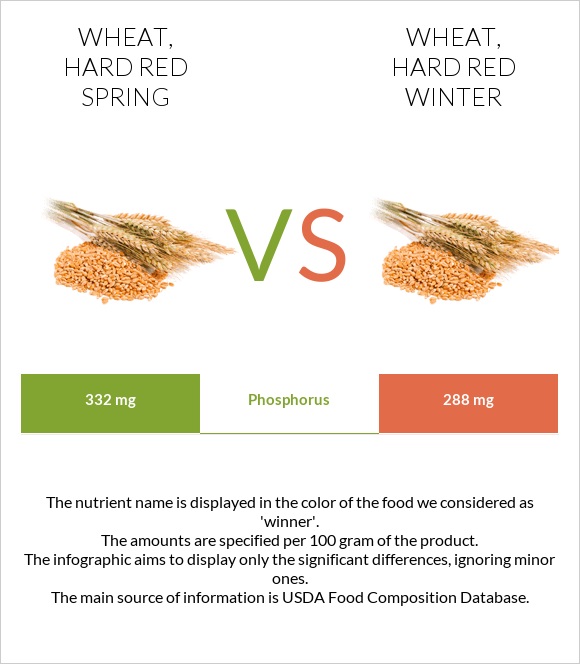Wheat, hard red spring vs. Wheat, hard red winter — In-Depth Nutrition Comparison
Compare
Summary of differences between wheat, hard red spring and wheat, hard red winter
- The amount of vitamin B1, phosphorus, and iron in wheat, hard red spring is higher than in wheat, hard red winter.
These are the specific foods used in this comparison Wheat, hard red spring and Wheat, hard red winter.
Infographic

Infographic link
Mineral Comparison
Mineral comparison score is based on the number of minerals by which one or the other food is richer. The "coverage" charts below show how much of the daily needs can be covered by 300 grams of the food.
| Contains more IronIron | +12.9% |
| Contains more PhosphorusPhosphorus | +15.3% |
| Contains more CalciumCalcium | +16% |
Vitamin Comparison
Vitamin comparison score is based on the number of vitamins by which one or the other food is richer. The "coverage" charts below show how much of the daily needs can be covered by 300 grams of the food.
| Contains more Vitamin B1Vitamin B1 | +31.6% |
| Contains more Vitamin B6Vitamin B6 | +12% |
| Contains more FolateFolate | +13.2% |
All nutrients comparison - raw data values
| Nutrient |  |
 |
DV% diff. |
| Vitamin B1 | 0.504mg | 0.383mg | 10% |
| Protein | 15.4g | 12.61g | 6% |
| Phosphorus | 332mg | 288mg | 6% |
| Iron | 3.6mg | 3.19mg | 5% |
| Copper | 0.41mg | 0.434mg | 3% |
| Manganese | 4.055mg | 3.985mg | 3% |
| Vitamin B6 | 0.336mg | 0.3mg | 3% |
| Vitamin B3 | 5.71mg | 5.464mg | 2% |
| Fats | 1.92g | 1.54g | 1% |
| Carbs | 68.03g | 71.18g | 1% |
| Potassium | 340mg | 363mg | 1% |
| Zinc | 2.78mg | 2.65mg | 1% |
| Folate | 43µg | 38µg | 1% |
| Polyunsaturated fat | 0.765g | 0.627g | 1% |
| Calories | 329kcal | 327kcal | 0% |
| Net carbs | 55.83g | 58.98g | N/A |
| Magnesium | 124mg | 126mg | 0% |
| Calcium | 25mg | 29mg | 0% |
| Sugar | 0.41g | 0.41g | N/A |
| Fiber | 12.2g | 12.2g | 0% |
| Sodium | 2mg | 2mg | 0% |
| Vitamin E | 1.01mg | 1.01mg | 0% |
| Selenium | 70.7µg | 70.7µg | 0% |
| Vitamin B2 | 0.11mg | 0.115mg | 0% |
| Vitamin B5 | 0.935mg | 0.954mg | 0% |
| Vitamin K | 1.9µg | 1.9µg | 0% |
| Choline | 31.2mg | 31.2mg | 0% |
| Saturated fat | 0.314g | 0.269g | 0% |
| Monounsaturated fat | 0.303g | 0.2g | 0% |
| Tryptophan | 0.195mg | 0.16mg | 0% |
| Threonine | 0.433mg | 0.365mg | 0% |
| Isoleucine | 0.541mg | 0.458mg | 0% |
| Leucine | 1.038mg | 0.854mg | 0% |
| Lysine | 0.404mg | 0.335mg | 0% |
| Methionine | 0.23mg | 0.201mg | 0% |
| Phenylalanine | 0.724mg | 0.592mg | 0% |
| Valine | 0.679mg | 0.556mg | 0% |
| Histidine | 0.33mg | 0.285mg | 0% |
Macronutrient Comparison
Macronutrient breakdown side-by-side comparison
Protein:
15.4 g
Fats:
1.92 g
Carbs:
68.03 g
Water:
12.76 g
Other:
1.89 g
Protein:
12.61 g
Fats:
1.54 g
Carbs:
71.18 g
Water:
13.1 g
Other:
1.57 g
| Contains more ProteinProtein | +22.1% |
| Contains more FatsFats | +24.7% |
| Contains more OtherOther | +20.4% |
~equal in
Carbs
~71.18g
~equal in
Water
~13.1g
Fat Type Comparison
Fat type breakdown side-by-side comparison
Saturated fat:
Sat. Fat
0.314 g
Monounsaturated fat:
Mono. Fat
0.303 g
Polyunsaturated fat:
Poly. Fat
0.765 g
Saturated fat:
Sat. Fat
0.269 g
Monounsaturated fat:
Mono. Fat
0.2 g
Polyunsaturated fat:
Poly. Fat
0.627 g
| Contains more Mono. FatMonounsaturated fat | +51.5% |
| Contains more Poly. FatPolyunsaturated fat | +22% |
| Contains less Sat. FatSaturated fat | -14.3% |